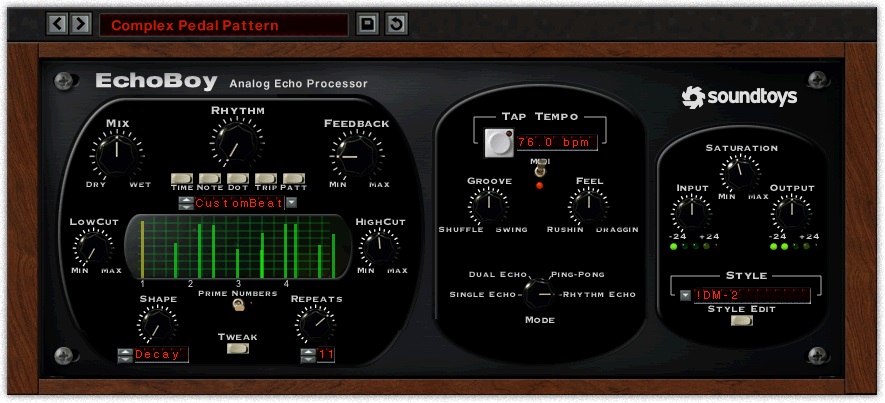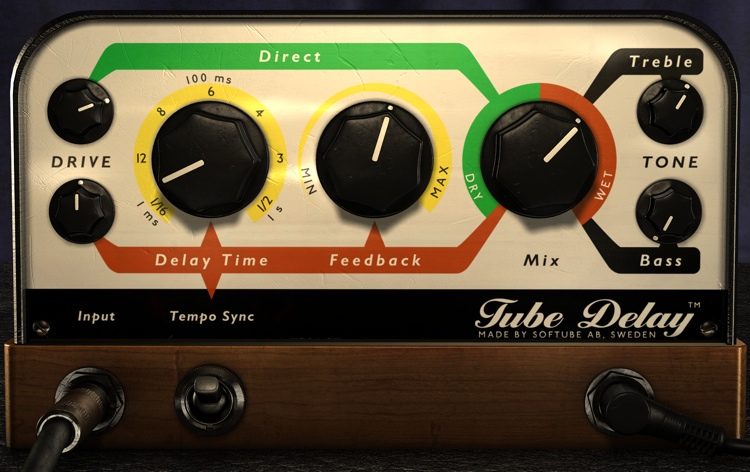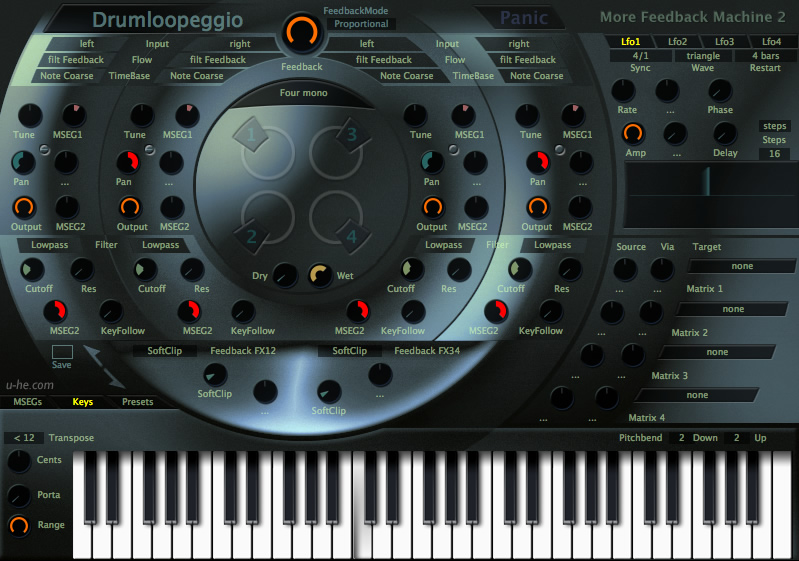The 10 Best Delay Plugins on the Market
Delay is an often underutilized tool in the audio engineer’s workstation. Sure, many of us may throw it on a vocal or maybe a guitar to add a little depth to the mix, but taking delay far beyond this often pays off in the end.
Today, we’re going to run down a top 10 list of what have become my favorite delays, divided into 5 different categories. Here’s how it’s going to go down: In each of these 5 categories, I’ll share my winner and a runner up.
Disagree? Tell us about it in the comments below! Each of these categories could easily hold five or more plugins that would all make a good showing, so don’t be too disappointed if your favorite didn’t show up on my list.
At the end end, you can even listen to or download some sample audio files I’ve created for each of these delays. The settings here weren’t crafted to be usable in an actual mix—or to try and mimic one other—but rather to present a very forward delay effect to showcase the distinctive way each plugin can sound without too much fuss.
With that out of the way, let’s dive into this top 10 list of the very best delays on the market.
Category 1: The Best Workhorse Delays
Let’s start off with the best workhorse delays. These plugins many not work in every situation, but will surely work in the vast majority of them.
While they aren’t always the “best” tool for every single job, they’re a surefire bet most of the time, almost always providing you a good baseline sound that you can work from.
For this category we are looking for a combination of ease of use, versatility, and overall sound.
Winner: Soundtoys EchoBoy
If you’ve poked around any area of audio, you probably saw this pick coming from a mile away. And there’s good reason for it.
Soundtoys’ EchoBoy has become my go-to delay for nearly any situation. It’s adaptable to a variety of different sources while maintaining a great sound, no matter which delay model you select. I could probably include it as a contender in almost any category on this list, but it’s certainly best suited here.
EchoBoy is like having 30 delays in one. It models classic units like the EchoPlex, Space Echo, Memory Man, DM-2, and TelRay oil can, putting all of them under one roof. You can dial in your settings and pop back and forth between different delay types, fine-tuning the sound simply by changing the model.
It doesn’t only excel in nostalgic emulations of old equipment, either. EchoBoy can handle a clean, straightforward delay with grace. Its “Studio Tape” model, for example, uses the Ampex ATR-102 for inspiration, bringing a subtle tape delay to your mix. You can drive the input like you would any machine to bring some tape saturation to bear as well.
In addition to the plethora of models, you get a smorgasbord of extra control over the sound. Like all Soundtoys plugins, there is a ton of power in the details. You can change up the type of distortion on the delay, create a custom echo tone in the Style Editor, or achieve a new rhythmic delay in “Rhythm Echo” mode.
Despite all the options, the plugin isn’t difficult to use. It is easily one of the most surefire, cost-effective and versatile delays out there, with a near endless array of quirky tones available, and the ability to achieve a great clean delay sound without too much trouble.
It’s become my first choice in most cases that I need to pull up a delay, and it should almost definitely be among the tools you keep in your DAW.
Runner Up: Slate Digital D16 Repeater

Slate’s D16 Repeater is another particularly flexible, good-sounding and easy-to-use option, making it a close contender in the all around “workhorse” category.
When Slate Digital announced Repeater as part of its Everything Subscription, many thought Echoboy would have a serious contender.
While this highly versatile delay has enough knobs and buttons to look the part, some of the deep customization options of Echoboy aren’t present, earning it the number 2 slot in this category. It’s a still a stellar workhorse, certainly—just not quite on the level of Echoboy. But it does have some features that are all its own.
In the D16, you have 23 different delay models to sample from, which you can tweak using the “color” knob. Depending on the model, this color can manifest as a telephone effect, pitch shifting, or just some simple tape tone. This color control is assuredly the most unique feature of Repeater, so pay some mind to it when you’re experimenting.
The rest of the unit is fairly typical delay fodder in most instances: You have timing, tap tempo, low and high pass filters, mix, panning, and feedback controls. The “Spread” switch on the bottom is bit unique, however. It provides either a 10ms or 20ms difference in the delay between left and right for a wider stereo field.
Despite this generous array of knobs, Repeater is quite a simple delay, and that’s part of what makes it such a workhorse. It sounds great, often with just a few minor tweaks. Repeater is also one of the first delays I often reach for, especially if I’m looking to dial in a quick tone without too much fussing about.
Category 2: The Most Versatile Delays
This next category is similar to our first one, but puts much more emphasis on flexibility than simplicity. These are delays that are great in a variety of situations, offering an abundance of different sounds to sculpt your source. However, they might not be quite as intuitive as our “workhorses”. While these tools may provide even more power in certain situations, it’s sometimes a bit more of a pain to get there. Let’s explore.
Winner: Fabfilter Timeless 2
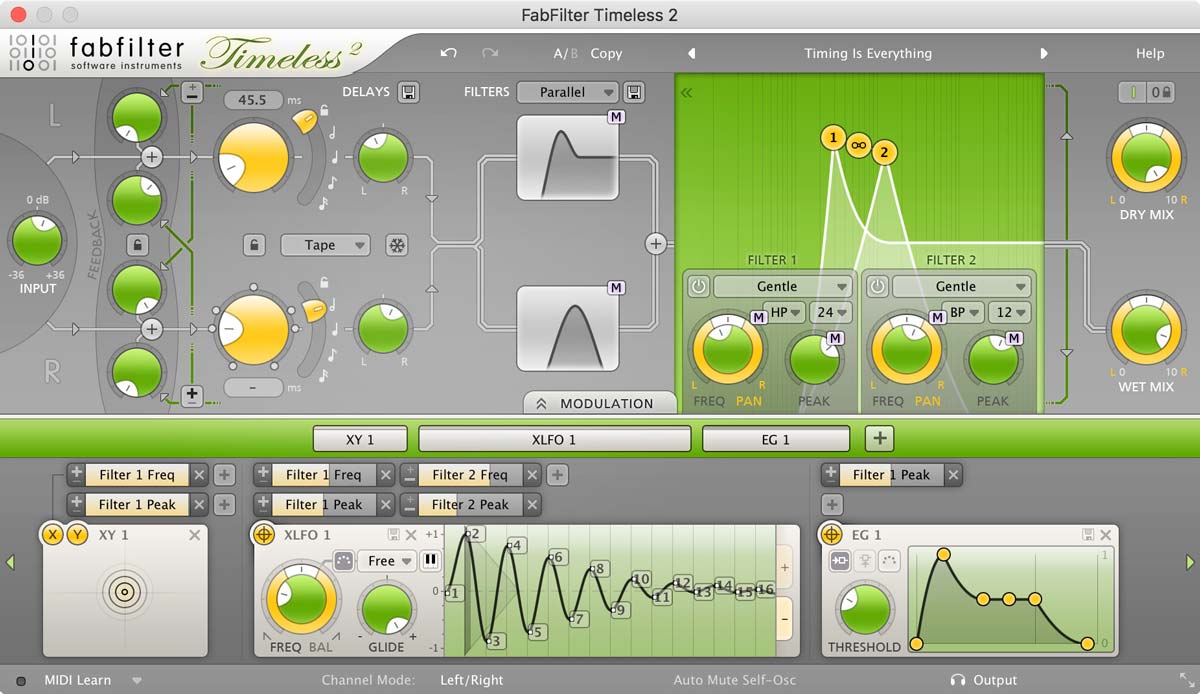
When you need even more versatility (and are willing to sacrifice a touch of simplicity to get it) an even more customizable delay like Timeless 2 can deliver.
Timeless 2 fits in a unique space because it can be a fairly straightforward plugin. Throw it up, tweak your mix, and the plugin already sounds great. However, like most Fabfilter plugins, there’s a lot going on underneath the hood. To take full control of this plugin, you’ll have to go deep in the trenches of its many settings.
Its default mode is a simple tape delay, expanded upon by a large number of modulation tools. With these tools, you can create flangers, phasers, chorus, scratching, and much more. Below the main plugin window, you’ll find all the filters for the delay including XLFOs, EFs, and XY controllers.
Once your setting is dialed in, you can drag the filter to any knob on the plugin to modulate it. Needless to say, the combinations are endless between different filter modules, shapes, and knob assignments. You can even assign a MIDI input to each of your filters as well to control the modulation on the fly.
As with nearly all Fabfilter products, the modulation settings are just the surface of the customization. Each filter has its own slew of settings and options, making for one of the most robust delays on the market.
The tradeoff is that all this robustness can come at the sake of saving time. It’s hard to resist going deep down the rabbit hole with this one, but sometimes, a little detour through wonderland is just what you need.
If you’re looking for all the bells and whistles, Timeless 2 absolutely delivers them. It has a pretty good stock sound as well, one that’s totally usable. But I find I usually reserve this plugin to creating truly unique sounds, and it always comes in handy in those cases.
Runner Up: PSP 85
As someone who likes to tinker, this one is a bit of a guilty pleasure. The PSP 85 is probably one of the best sounding delays out there, and it really excels when you use it for generating unusual time-based effects. As you’ll hear in the demo clip at the end, the 85 can create vast, moving soundscapes, achieving a sound that would normally require multiple plugins to generate.
On the surface, the PSP 85 appears to be a simple delay, with an interface similar to Slate’s Repeater. Settings for time, pre-delay, mix, and feedback are the bread and butter of the unit, allowing you to craft a simple, although fantastic sounding, echo.
The plugin also comes with an LFO, a modulator, and a reverb built in. The combination of these three additional processors is where this plug shines. You can create lush soundscapes using the reverb with the delay, or craft a responsive echo using the LFO and modulation. There are a ton of possibilities enabled by only a small set of additional features.
All those possibilities however, come at the cost of simplicity in use. Like Timeless 2, the advantage of this plugin comes from putting in the time to tweak. You’ll need to sit and fuss around with the controls for a while to get the perfect sound. However, once you get there, it’s hard to imagine creating such a novel delay with any other plugin.
Category 3: The Best Dirty Delays
It’s time to get into the dirt: These are delays that sound their best pushed to the limits, fit with all the distortion you could ever want. As some of the options in this category can get quite expensive, I took the price into account when making my top picks, giving bonus points for affordability along with tone.
Winner: Softube Tube Delay
Tube Delay is such a brilliantly simple plugin that it’d be a sin not to include it for this category. It’s easy to use, sounds fantastic, and has a low price tag to boot.
It employs a vintage-style passive EQ that can go from clean to dirty at the turn of a knob. Whether you’re trying to add some depth with a rolled-off echo or really slam the drive for a dirty vocal, Tube Delay can accommodate.
The tube preamp model is routed to two different parts of the delay. You can overdrive the source, the delay, or both, allowing you to simply use the plugin as a distortion device if desired—and it works quite well in this fashion too. The drive knob never becomes too overbearing or nasty. Instead, it sounds like natural breakup throughout, which is quite a feat considering the low price tag of the plug.
On the backend, you have controls for bass and treble. Unfortunately, these EQ controls impact the overall sound, not just the delayed signal. Roll off some treble and, sure enough, your direct vocal sound will have less top-end as well. This issue is easily alleviated by routing your vocal through a bus with the plugin, like many engineers will do, but it is still something that should be noted if you often strap your delays across individual tracks. In either case, automating that treble control can create a really sweet sweep effect.
Outside of that, the plugin is fairly straightforward, with just one other unique feature: The feedback knob allows you to get a very convincing dub echo sound. The delays stack on top of each other, driving not only the delay, but the distortion further and further into chaos as well. Using a long feedback with the treble automation can create a truly insane effect.
Softube’s Tube Delay is a simple, cheap plugin that manages to achieve both excellent quality and usability. It’s dirty, yes, but still has a surprising amount of range. You can easily throw the plugin up and dial in a clean delay with subtle tube distortion or go directly into madness with massive amounts of overdrive and a pinned feedback knob.
Runner Up: UAD Galaxy Tape Echo
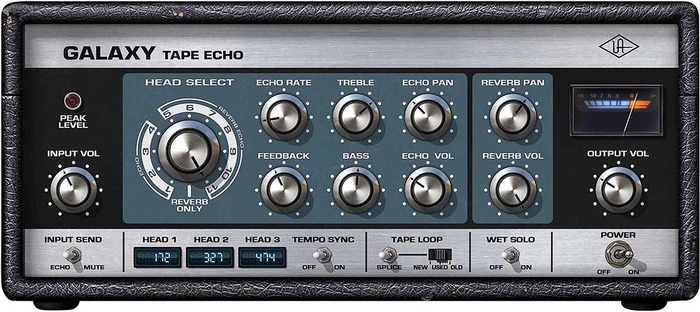
When only the best in vintage vibe will do, a faithful recreation like the RE-201 from UAD can be one of your best bets.
I know UAD’s plugins are often expensive compared to their competitors, but this one is too good not to mention. If it wasn’t for the cost of an entire UAD system, this one would easily take the top slot for me. The Galaxy Tape Echo adds a realistic breakup to your track, with options for different tape models, reverb and tape head positions.
Unlike Tube Delay, this is more like a toolbox for dirty delays. The different tape models and tape head positions lead to wildly different sounds, with an extra reverb on the backend for unique sounds. It’s a true recreation of the RE-201—and one that will cost you a bit of extra money over the Softube. Even so, that price is surely worth it if you have the money to spend.
As you’ll hear in my sample clip at the end, I went for a dream-like echo, one that moves and responds to the track throughout the stereo space. It sounds a bit like the PSP 85 sample, minus the unique filters. Instead, those filters are replaced by a subtle breakup that reacts differently depending on where the delay is at.
For the money, you’re getting quite a lot here. It is simultaneously an authentic recreation of the Roland RE-201 and one highly versatile plugin, especially for saturated delay effects. It sounds great, and has fantastically fun usability to boot. If you already own a UAD system, you owe it to yourself to at least give this one a try.
Category 4: The Best Multi-Tap Delays
Next, let’s look at the best “multi-tap” or “multi-delays”. These delays work especially well for creating a crazy wide sound, with eight or so delays overlapping over one another, often with a unique stereo spread, and can allow you to create unusual or semi-random rhythms.
Delays like these probably aren’t going to be the first ones you’ll reach for in most cases, but when you do, they can provide the kinds of sounds that other units just can’t match.
Winner: PSP 608
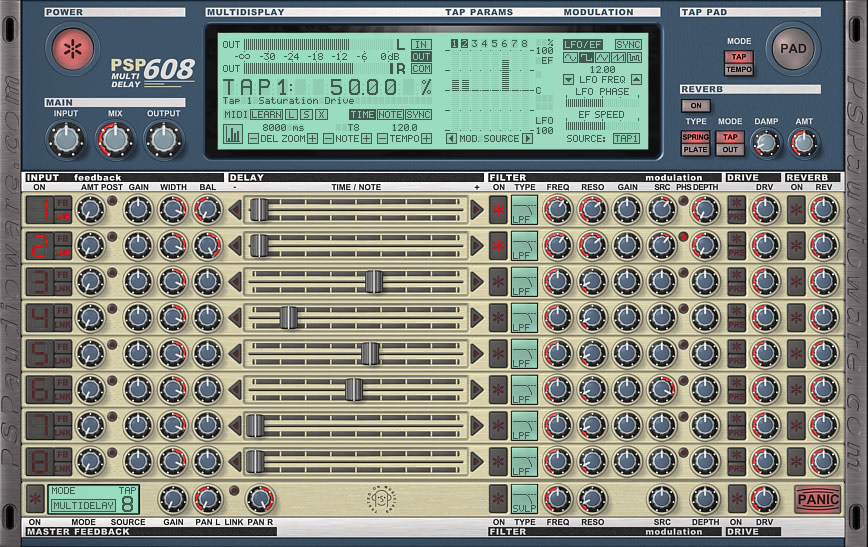
Multi-delays can do things other delays just can’t. In that category, the PSP 608 is simple, effective, sounds good, is easy to use, and comes in at a great price.
PSP’s 608 multi-delay is a fairly simple plugin. You have eight separate delays, each fit with its own settings of delay time, feedback, panning, and mix. However, the plugin goes far deeper if you dive into all the options, allowing you to create wide delays that stretch across the stereo spectrum.
Each band has its own “filter shape” selection with modulation controls. You can modulate any one of the single delays up to three octaves in either direction, opening the possibility for some pretty wild echo effects. You can open a filter while panning a delay across its eight channels, or ping pong a stereo delay back down into mono.
On top of all this, PSP gives you reverb and distortion knobs for each band. The reverb comes in two different flavors, either spring or plate. There’s a universal dampening control as well as individual controls for the mix. Just like with the PSP 85, discussed earlier, you can use the reverb in combination with the delay to turn a simple sound source into a wide pad.
The Drive controls simulate tape saturation. It isn’t quite on the level of the plugins in the previous category, but the distortion here is still decent enough to use subtly in a mix. You can adjust the saturation globally across all eight bands, or set each one individually, complete with a control for whether you are saturating pre or post delay.
The demo clip below takes full advantage of the eight bands, slowly closing the filter as the delay disappears into mono. You can, however, go with a far subtler effect and use the 608 for a ultra fast slapback.
Despite all of the options, the 608 is extremely easy to use. The eight bands all have the same functions and a little poking around will generally yield a pretty unique sound. It’s easy to go into guilty pleasure mode here, so be vigilant when throwing this delay up on a track. You can end up doing a lot more with it than you had planned.
Runner Up: Cargo Cult Slapper
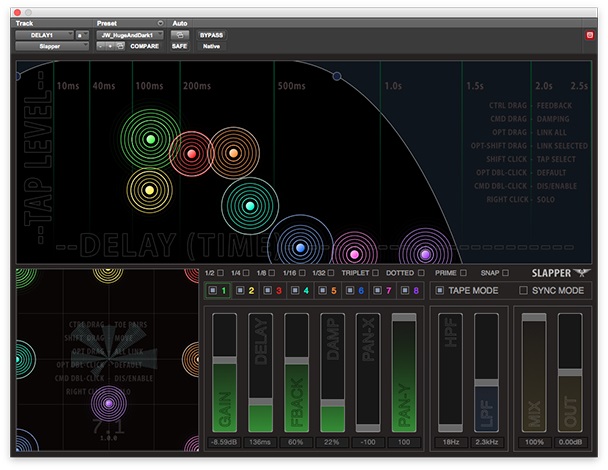
Slapper employs a unique visual approach to representing and manipulating a must-delay, complete with full surround capabilities.
Slapper has to be one of the more unique delay plugins I’ve ever seen. It uses a graphical interface to show the state of the multi-delay, giving visual feedback as the source pass through each of them. This representation of time and level allows you to fully grasp how your delay is functioning, leading to a more intuitive workflow without sacrificing sound.
The top area of the plugin shows a graph, displaying delay time on the X axis and delay level on the Y axis. It’s easy to drag these few buttons around and arrange your delay in a way that trails off as the delays get longer, or one that bounces to a particular rhythm. This area also shows the high and low pass filters for each band.
Below that is a representation of the full surround space. You can drag any of the delays around the space, creating ultra-wide surround echos. Between the two options, you can create a delay that wraps around the listener, bouncing across 7.1 surround. One effect that worked really well in my tests was to use the surround space for a rhythmic delay that accents other parts of the arrangement.
There is no reverb in the plugin, however. The people of Cargo Cult did this for a reason however, saying that “we’ve been reaching for the delay most of the time, and finding less and less use for traditional reverbs.” While the reverb-like delay effects you can achieve with this plugin sound great, you don’t have quite as many options for creating a soundscape as you do with something like PSP’s reverb-equipped 608.
Category 5: The Best “Miscellaneous” Delays
Rounding out this delay roundup are a couple of options that don’t neatly fit in any other category. As opposed to having a winner and honorable mention here, these two delays sit on their own, each offering completely unique takes on a timeless effect.
If you know nothing about the MFM2 and simply listen to my sound test, you might mistake it for a simple multi-delay. That couldn’t be further from the truth. Developed by a company that focuses primarily on creating unique digital synthesizers, the MFM2 adopts a familiar look with a slew of options for filtering and modulation.
Admittedly, I don’t know much about synthesizers outside of their basic operation. As a mixing engineer with a limited understanding of synths, the MFM2 freaks me out whenever I load it up. However, that doesn’t mean I can’t take advantage of all it has to offer.
The basis of the plugin is in four separate delay lines that you can route in a number of ways. Each line includes a multimode filter with controls for cutoff and resonance. On the other side of the plugin, there are four LFOs with eight waveform options and user-definable curves.
Any of the four delay lines can be routed across any of the 4 customizable LFOs. You can modulate a delay signal statically through just one of them, or dynamically move a filter across the spectrum. At the end, there are two compressors built in to make sure any crazy effects don’t get out of control.
For my tastes, the MFM2 is often a bit much. The unconventional design is bit difficult to get used to after years of using more straightforward delay units. However, if you’re familiar with synthesizers and can take full advantage of all the options the MFM2 presents, you’ll find a delay that’s truly unique in the audio space.
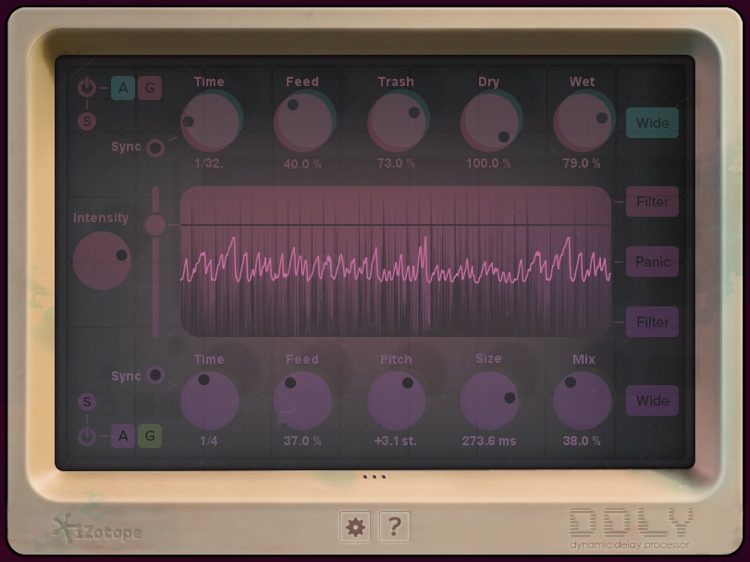
iZotope’s DDLY adds a unique threshold control and “grain” manipulation that makes it a memorable delay option that’s not quite like any other.
Rounding out this list is another one of the most unique plugins I’ve seen. The DDLY is fit to create wild effects, with a dynamic delay engine that can change in response to the sound sources you feed it.
They key feature here is that you can set a threshold for the delay so that it only reacts to signals that go above that threshold, making the plugin strike a strange line between an expander/gate and a delay.
For my tests, I ditched the vocal and instead used DDLY on some drums. Here, you can really hear how the delay reacts differently to the elements of the kit, creating a unique rhythmic complement for this highly dynamic source.
The core of the plugin is found in two separate delay channels. There’s not much that’s special going on with either—the two channels simply feed separate delays to the output. But you do have the choice of using the standard tape delay, which has a bit of lo-fi saturation, or the “Grain” setting which splits the delay up over multiple grains of size and pitch and can yield some pretty out-there and computerized-sounding effects.
The real star of the show here however, is that threshold control. Combining two unique delay tones and accenting only certain parts of the source is something that no other single plugin can really do. The DDLY can create wild effects unique to itself and is certainly worthy of pickup, even if it’s only used in a few niche cases.
Final Thoughts
The above have become some of my favorite delays, from ones I use everyday to others that come in handy in a pinch.
As you may have noticed, there are so many delays on the market that I couldn’t possibly cover each and every one I use in detail. Some other great plugins worth an honorable mention include the Waves H-Delay, Brainworx bx_2500, Native Instruments Replika XT, UVI Relayer, and UAD EP-34.
If I missed one of your favorite delays, be sure to let me know which one in the comments below, and why you think it should make the list!
Jacob Roach is a writer, producer, and engineer from St. Louis, Missouri.
Thanks to Lily Oyer for her vocal contributions for the audio samples below. To download the full resolution versions, click here.
Please note: When you buy products through links on this page, we may earn an affiliate commission.







